
“The most significant pleasure in the world is to invent the world as it is, without inventing anything.”
A monumental masterpiece executed equally on the oft opposed foundations of conceptual rigor and technical brilliance, Alighiero Boetti’s Mappa from 1989 to 1991 triumphantly encapsulates within its borders both the crux of artistic skill and the most essential elements of our human story. The outright iconic power of Mappa is undeniable: like Jasper Johns’ Flag or Andy Warhol’s Campbell’s Soup Can, the world map has been appropriated by Boetti here so completely and strategically that it has become synonymous with his legacy. Begun in 1971 and pursued until his death in 1994, Boetti’s Mappe comprise the artist’s most celebrated corpus, a deeply insightful philosophical project executed to achieve a fundamental human universality through the most personal methods of fabrication and exchange. The present work belongs to the largest group of Boetti’s Mappe, of which only few exist and two remain in the late artist’s family, and is among his most historic, with its cartographic composition informed by the unprecedentedly transformative era of global history that occurred between 1989 to 1991. Testifying to its significance, Mappa prominently exhibited in Boetti’s international 2011-2012 retrospective Game Plan, co-organized by and shown at the Museo Nacional Centro de Arte Reina Sofia in Madrid, the Tate Modern in London, and The Museum of Modern Art in New York, as the largest presentation of the artist’s work outside Italy. With inherent artisanal finesse, the personal and the political coalesce in the delicately woven ivory surface of Mappa, enacting on a prodigious scale a meticulous meditation on the dialectical forces that bind and divide humanity.
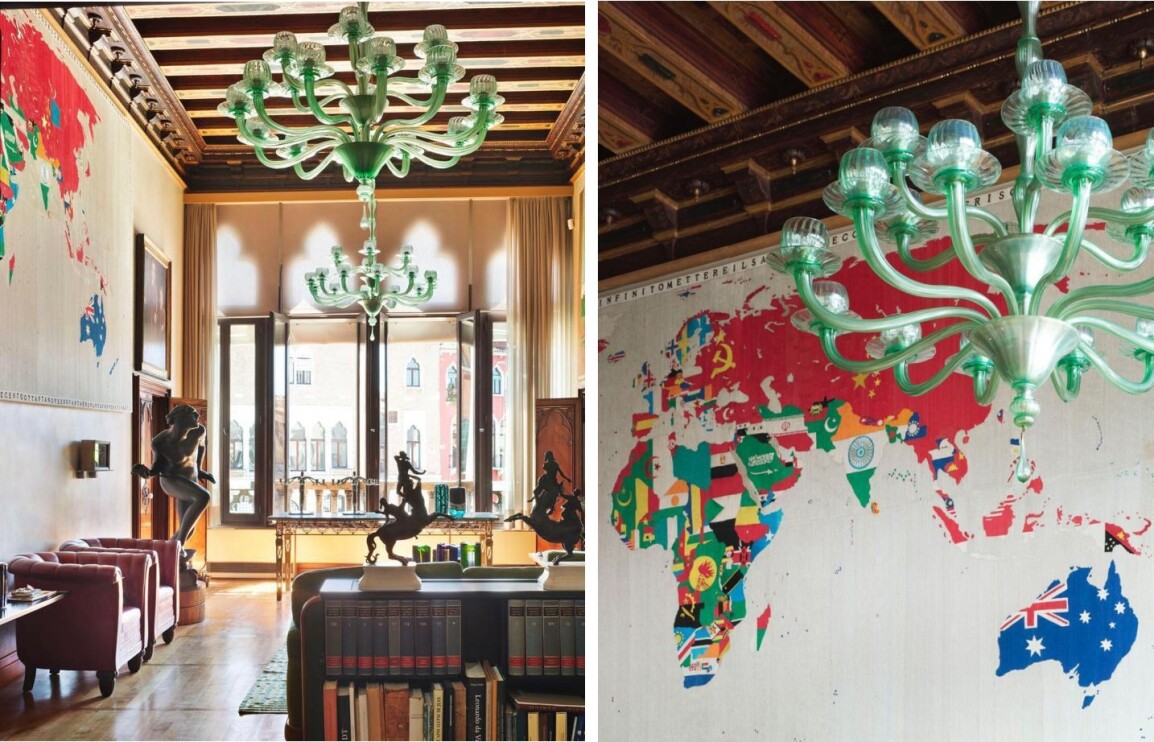
Alighiero Boetti’s Mappe bore witness to every change to the physical borders and flags of every nation in the world 1971 to 1994, providing a grand historiographic account of global geopolitics during this period. Over twenty years, Boetti conceptualized and oversaw the execution of approximately 160 Mappa works, each unique and all representations of the everchanging classifications of the world map, which he interpreted as a political construct borne from the human impulse to demarcate the earth. Charged with global political consciousness, Boetti’s Mappe also reflect the artist’s natural inclination toward beauty in matters both out of his control and already existent: “The most significant pleasure in the world is to invent the world as it is, without inventing anything.” (the artist cited in Alberto Boatto, Alighiero e Boetti, Ravenna 1984, p. 122). As each Mappa oscillates between the present moment and the pre-existing past it displays, Boetti suspends time and reality in a composition that is near otherworldly. In the present work, we begin to transcend the boundaries of past and present, the historic and contemporary, existing solely in a universe of Boetti’s own making as we stand awash in the luminously ivory hue of the oceans that span the expanse of Mappa.
"For me the work of the embroidered Mappa is the maximum of beauty. For that work I did nothing, chose nothing, in the sense that: the world is made as it is, not as I designed it ... when the basic idea, the concept, emerges, everything else requires no choosing."
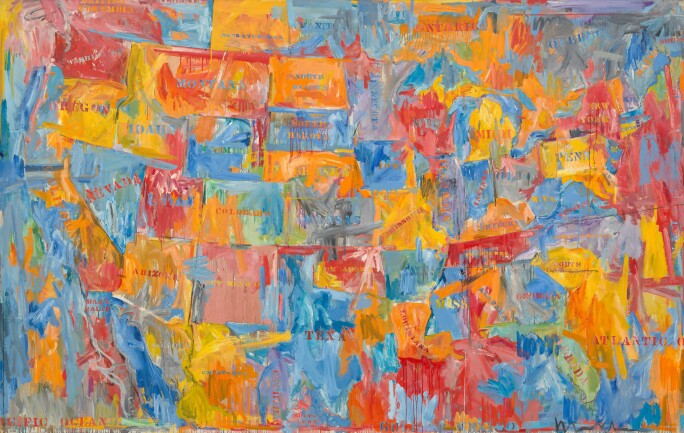
A brilliant display of national flags across the world map, Mappa also captures the very essence of the transformative global era that began with the fall of the Berlin Wall in November 1989, the catalyst behind a series of radical and definitive political changes across Eastern Europe. The momentous impact of the events of 1989 to 1991 on the course of world history cannot be overstated, for in the span of only three years, the world seemed to collectively pivot to set an entirely new sociopolitical course for the future. Also in 1989, for instance, pro-democracy protests shook Tiananmen Square, resulting in the declaration of martial law in Beijing; in 1990, Nelson Mandela was released from Victor Verster Prison as a symbolic first step toward the end of Apartheid in South Africa; and in 1991, the United States officially entered Kuwait with air strikes against Iraqi forces, launching the first phase of Operation Desert Storm. With its construction paralleling this critical timeframe of international affairs, Mappa is elevated beyond its status as a work of art to a historical memento of prodigious narrative import.
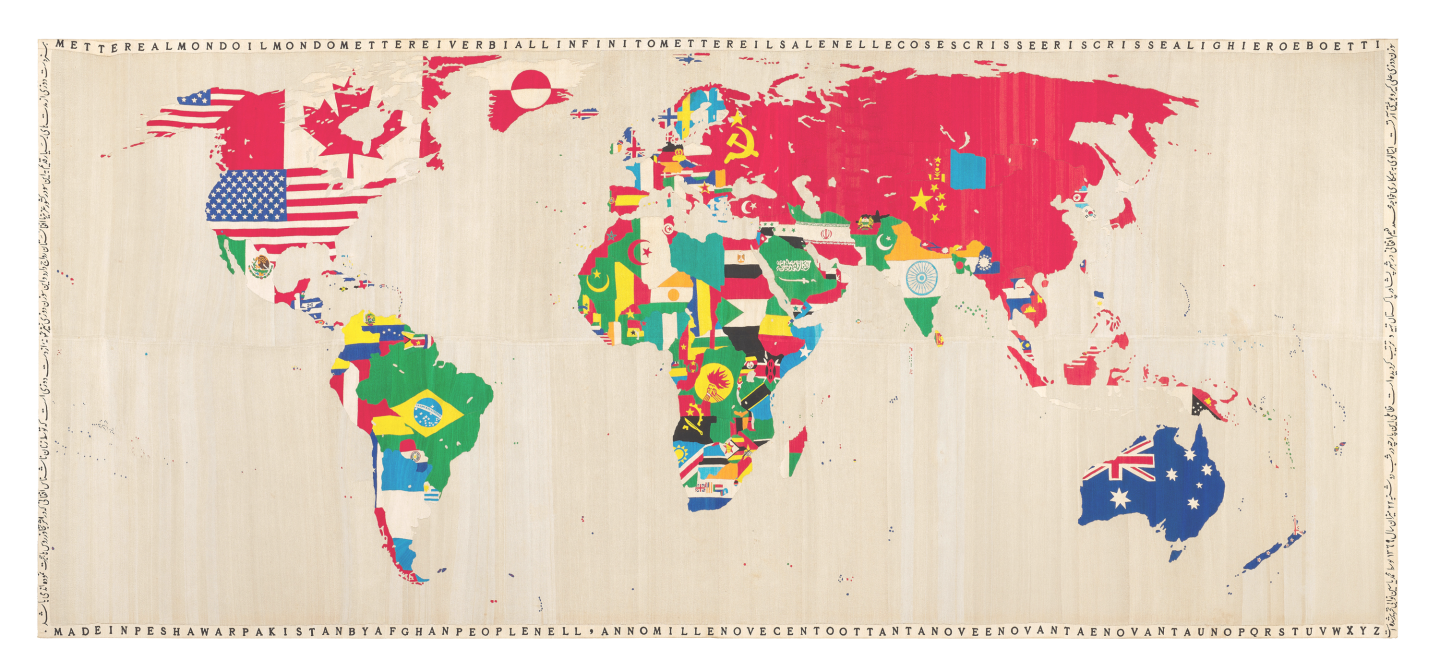
- February 1990

PAARL, SOUTH AFRICA - FEBRUARY 11: ANC leader Nelson Mandela and wife Winnie raise fists upon his release from Victor Verster prison, 11 February 1990 in Paarl. (Photo credit should read ALEXANDER JOE/AFP/Getty Images) ALEXANDER JOE/AFP/Getty Images Nelson Mandela was released from Victor Verster Prison after 27 years behind bars in a symbolic first step toward the end of Apartheid in South Africa.
- April-June 1989

BEIJING, CHINA - 1989/06/01: The "Goddess of Democracy" stands tall amid a huge crowd of flag waving pro-democracy demonstrators in front of the Mao Tse Tung portrait in Tiananmen Square. Art students made the polystyrene and plaster statue in the style of the Statue of Liberty to represent their desire for a more democratic rule in Communist China. Once erected in Tiananmen Square this proved to be the last act of defiance by protestors as a few days later government troops brutally suppressed the democratic movement.. (Photo by Peter Charlesworth/LightRocket via Getty Images) Peter Charlesworth Pro-democracy student protests shook Tiananmen Square, resulting in a massacre of protestors and the declaration of martial law in Beijing.
- November 1989

The Berlin Wall began to fall after dividing Germany for nearly forty years. The wall symbolized the “Iron Curtain” that separated Western Europe from the Eastern Bloc during the Cold War, and its destruction would catalyze a series of radical and definitive political changes across Eastern Europe.
- January 1991

US Marines roll into Kuwait International Airport in light armored vehicles after the retreat of Iraqi forces during Operation Desert Storm. Feb. 27 1991. BSLOC_2011_12_5 Courtesy Everett Collection PUBLICATIONxINxGERxSUIxAUTxONLY Copyright: xCourtesyxEverettxCollectionx HISL027 EC245 Courtesy Everett Collection via www.imago-images.de/imago images/Everett Collection The United States officially entered Kuwait with air strikes against Iraqi forces in the first phase of Operation Desert Storm.
- November 1990

Tim Berners-Lee publishes the first formal proposal for the World Wide Web at CERN, the European Organization for Nuclear Research, marking the inception of the Information Age and the Digital Revolution
- March 1990

After occupation for half a century, Lithuania declares independence from the Soviet Union, becoming the first Baltic state to assert state continuity.
- December 1989

Shortly following the fall of the Berlin Wall, U.S. President George W. Bush and Soviet leader Mikhail Gorbachev declared the end to the Cold War in a meeting off the coast of Malta. At the time, this meeting was referred to as one of the most important since World War II.
- September 1991

In Port-au-Prince, Haiti, a coup d'état led by Haitian military officers removed President Jean-Bertrand Aristide from power, who was only elected eight months earlier as Haiti’s first democratically elected president.
- December 1989-January 1990

For briefly over a month, the United States invades Panama under President George H. W. Bush to depose the de facto Panamian leader, General Manuel Noriega.
- December 1991

The Soviet Union officially dissolves, its hammer and sickle flag replaced by the Russian tricolor thereafter. Mikhail Gorbachev resigned as the President of the Soviet Union and is taken over by Boris Yeltsin as multiple separate republics from the Communist monolith become newly sovereign.
In Mappa, the immediate sense of detachment suggested by Boetti’s stylistic use of the flag – the most basic and readily identifiable visual emblems of each nation -- is swiftly belied by the overwhelming human presence felt in each stitch as one encounters this majestic work. Across the expansive surface of Mappa, we are irrepressibly attracted to the fundamental tactility of the work, a persistent reminder of the hours, days, weeks, and years it took for a group of dedicated embroiderers to painstakingly create it.

Following a trip to Afghanistan in 1971, Boetti visited the Middle East twice annually, where he recruited skilled Afghan women from local ebroidery schools to produce his intricate Mappe series. Boetti encouraged the artisans to take creative liberties with the color of the oceans and borders of each tapestry, a conceptual decision intended not to separate himself from his art but rather to inweave the creative spirit of others into each finished product. An appreciative reminder of the cross-cultural and collaborative labor behind the present work, along the upper and lower borders of Mappa is delicately woven in English: “Made in Peshawar Pakistan by Afghan people in 1989 and 90 and 91.”

Boetti's Mappe in Museum Collections
Boetti’s ceaseless pursuit of dialogue with other cultures, combined with an experimental bent, a playful spirit, and above all, conceptual rigor, resulted in a corpus infused with the sublime surprises brought on by chance and coincidence and representative of the artist’s genius within the lineage of Conceptual Art. Jasper Johns, perhaps Boetti’s most direct American counterpart, similarly engaged a persistent preoccupation with a small number of highly venerated subjects – Flags, Maps, Targets, Numbers – which were chosen and praised by Johns for their status as “pre-formed, conventional, de-personalized, factual, exterior elements.” (Jasper cited in Richard Francis, Jasper Johns, New York 1984, p. 21) With his Mappe series, however, Boetti elevated these fundamental tendencies of Conceptualism expressed by Johns when he states, "For me the work of the embroidered Mappa is the maximum of beauty. For that work I did nothing, chose nothing, in the sense that: the world is made as it is, not as I designed it, the flags are those that exist, and I did not design them; in short I did absolutely nothing; when the basic idea, the concept, emerges, everything else requires no choosing." (The artist quoted in Luca Cerizza, Alighiero e Boetti: Mappa, London 2008, p. 1) In an ultimate nod to Duchamp, and a marked leap even further into conceptual mastery than Johns, Boetti allowed his idea to become his final artistic act, entrusting the fate of the world and his skilled band of Afghan artisans to realize his vision in Mappa.
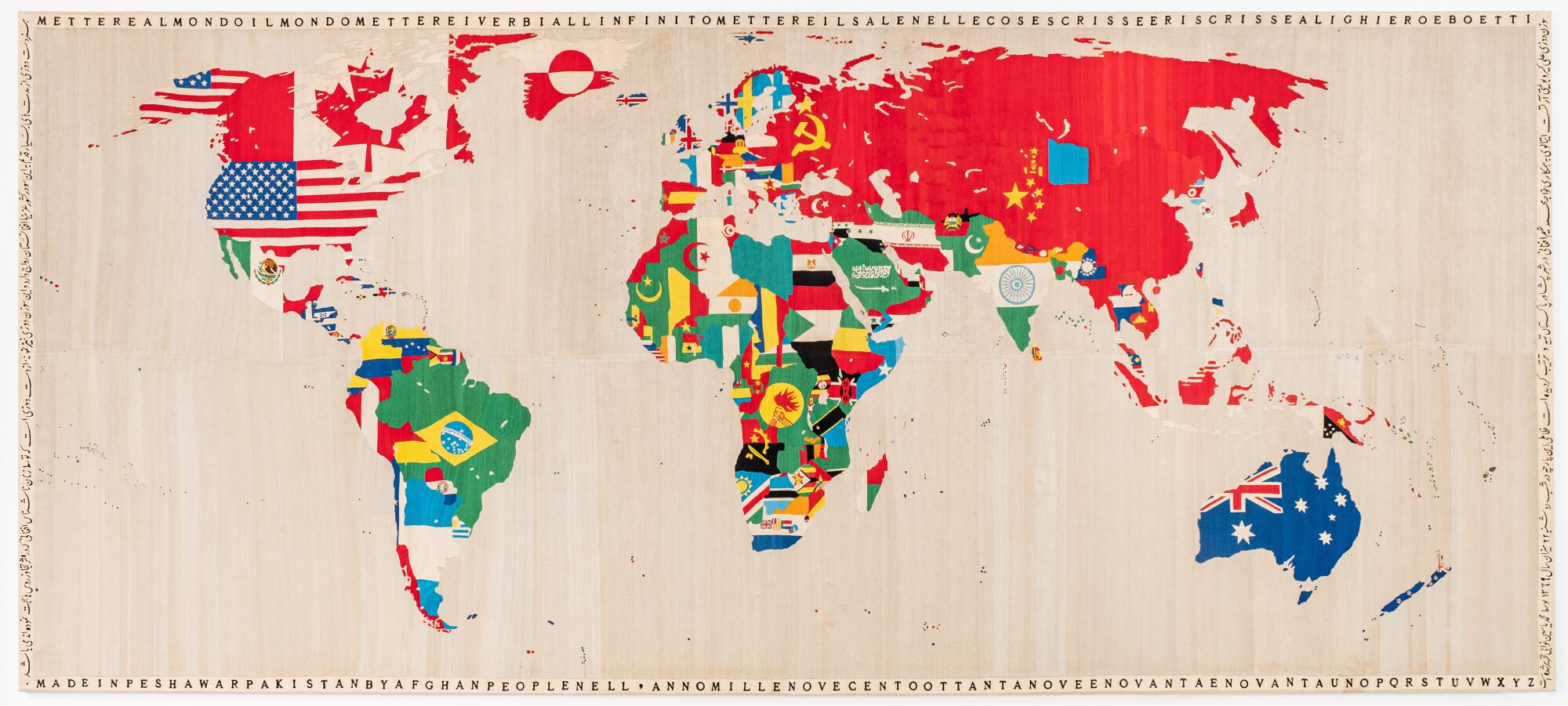
Interweaved throughout the present monumental work is a cross-cultural exchange and process that perfectly realizes Boetti’s propulsive desire to curate the unexpected and orchestrate global encounters. Though nations constantly change and form as political tides transform borders, Mappa from 1989 to 1991 presents the viewer with a momentarily standstill image of the world, even amid a historic period of tumultuous political flux.
In this context, if the iconography of the national flags in the present work suggests the artificial, erratic, and fragile systems of division that humans have imposed upon the earth, then the blank, ivory seas of Mappa represent an open place for creativity and freedom liberated from the constraints of patriotic identity, evincing a truly international body of water. And ultimately, the kaleidoscopic ensemble of various countries’ flags manipulated to fit within their geographical borders achieves a joyful explosion of colors and shapes, creating a sonorous composition of dazzling chromatic contrasts in Mappa that visualizes the creative potential that Boetti has always sought after and discovered in our world.
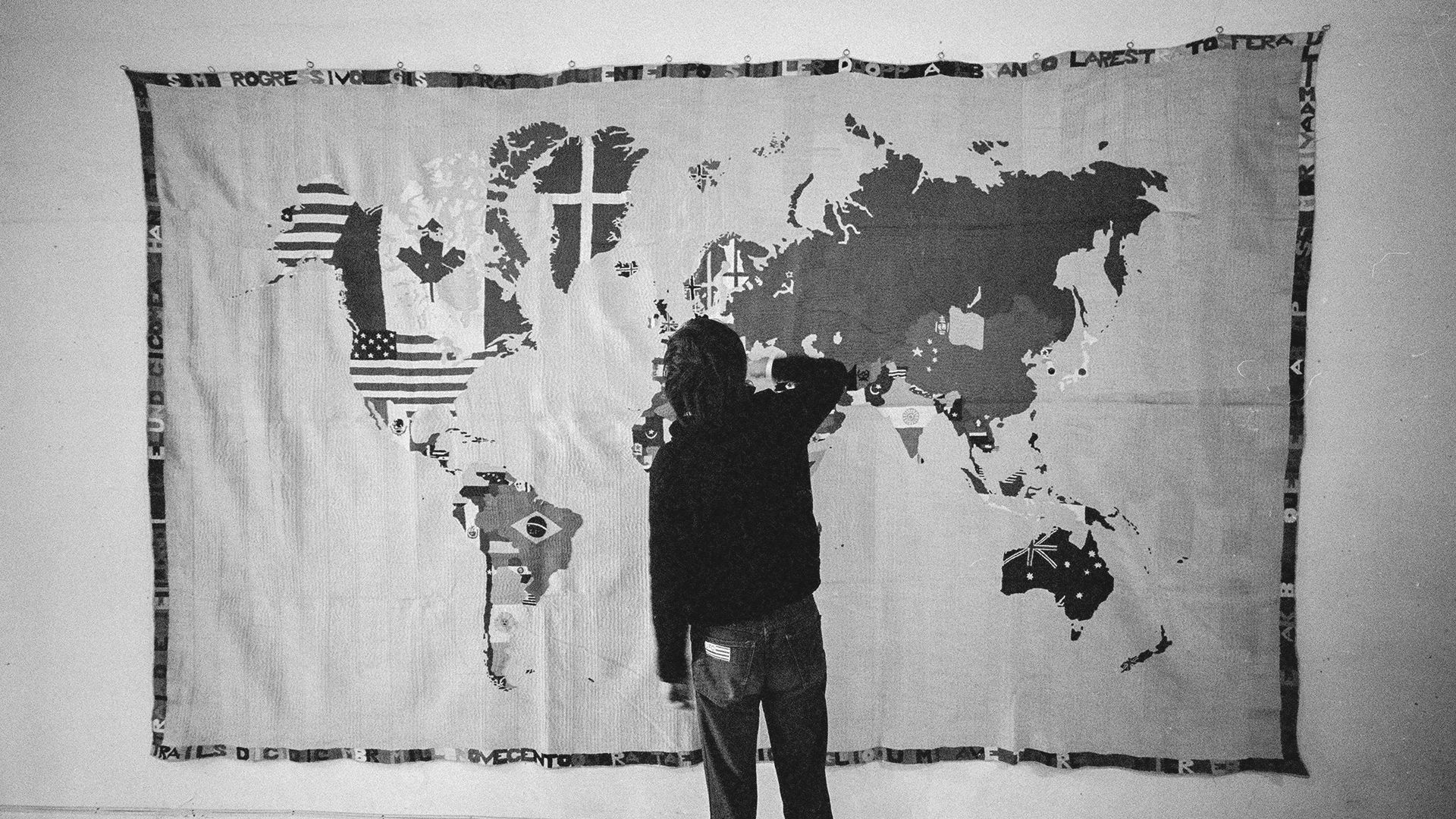
“He had the mind of a collector. He was methodical in spotting, waiting for and choosing the right piece, and knowing when to sell one piece of glass for something better. Straight away we understood that this passion would grow, although in different ways. Every piece was found, pursued, desired and selected, so that it could interact with the surroundings it would be placed in. First, they were put in our house, whose size and structure could accommodate medium and large pieces. Now, luckily, they are all housed in the collection space at Ca' Pesaro.”
The enduring desire of Francesco Carraro, supported by his wife Chiara, was to create a Foundation to preserve and display his collection according to his aesthetic and cultural convictions. This guiding vision led to the creation of an unparalleled collection of masterpieces, chosen by Francesco himself with an artistic narrative encompassing the early 20th Century. Francesco’s unique vision and taste is now a legacy to his beloved Venice, and the collection is on display at the Galleria di Arte Moderna at Ca’ Pesaro since 2017.

Overlooking the Grand Canal, Ca’ Pesaro is one of the most impressive and prestigious palazzos in Venice. Thirty years of research, discovery, experience in collecting and love for the arts fill the two rooms with works by De Chirico, two mature masterpieces by Morandi, the Polittico Garagnani by Severini, Il bevitore and La Pisana by Martini, Wildt’s Maria dà luce ai pargoli cristiani, and a rare oil painting by Gino De Dominicis, among others. In dialogue with paintings and sculptures, the Fondazione Carraro features over eighty Murano glass masterpieces executed between 1910-60 by Barovier, Bianconi, Buzzi, Martinuzzi, Scarpa and Venini. Venice has always been at the centre of Chiara and Francesco's story and has been a powerful source of inspiration whose echo resounds even today.
Francesco Clemente on Alighiero e Boetti | TateShots





























